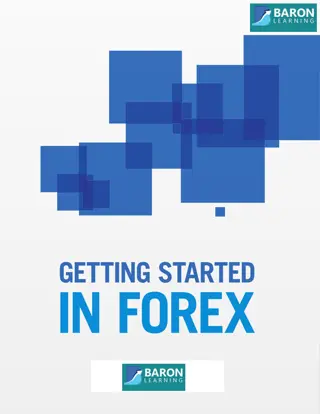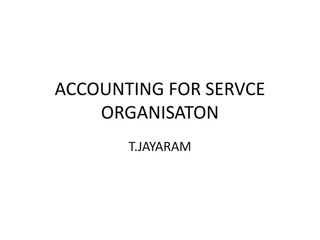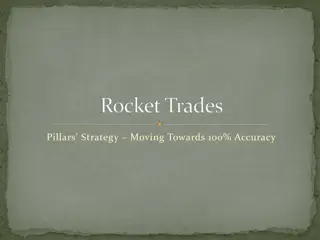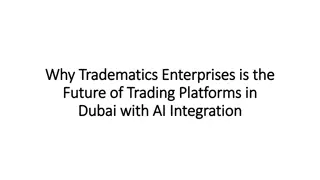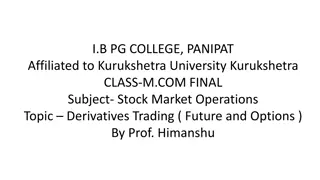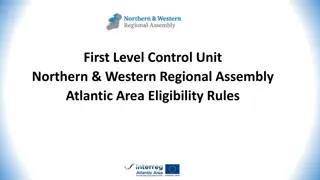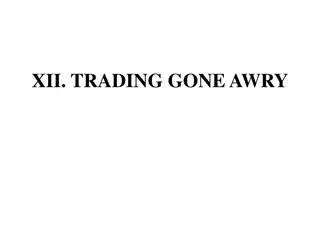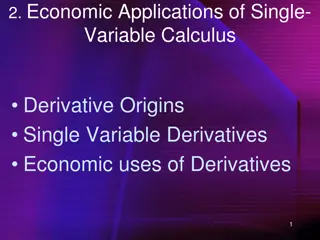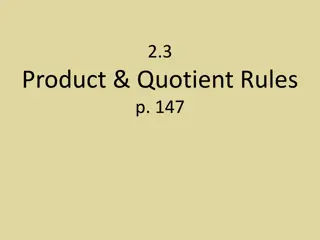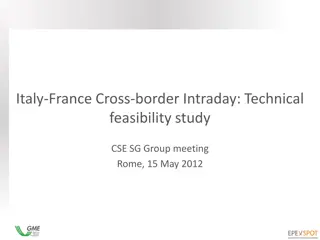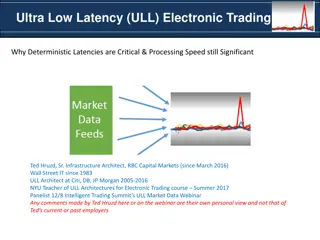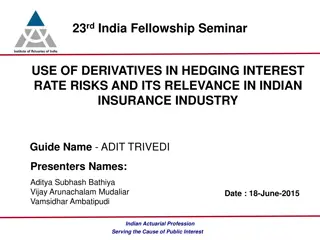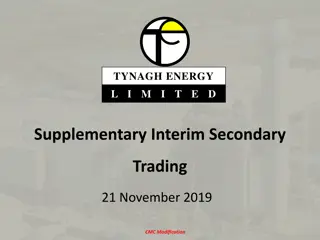New EU Rules on Derivatives Trading and Reporting
The EMIR reporting technical standards and obligations for derivatives trading under the new EU regulations. Learn about the reporting requirements, exposures monitoring, and timelines for compliance. Stay informed to adapt to the changing landscape of derivatives trading."
Download Presentation

Please find below an Image/Link to download the presentation.
The content on the website is provided AS IS for your information and personal use only. It may not be sold, licensed, or shared on other websites without obtaining consent from the author.If you encounter any issues during the download, it is possible that the publisher has removed the file from their server.
You are allowed to download the files provided on this website for personal or commercial use, subject to the condition that they are used lawfully. All files are the property of their respective owners.
The content on the website is provided AS IS for your information and personal use only. It may not be sold, licensed, or shared on other websites without obtaining consent from the author.
E N D
Presentation Transcript
New EU Rules on Derivatives Trading The EMIR Reporting Technical Standards Victoria Cooley OTC Derivatives & Post Trade Policy Financial Conduct Authority 1
Agenda 1. Introduction to EMIR 2. The reporting requirements 3. Frequently asked questions 4. Reporting to trade repositories 2
Introduction G20 statement in Pittsburgh: All standardised OTC derivative contracts should be traded on exchanges or electronic trading platforms, where appropriate, and cleared through central counterparties by end-2012 at the latest. OTC derivative contracts should be reported to trade repositories. Non- centrally cleared contracts should be subject to higher capital requirements. 3
Reporting obligation Applies to all counterparties to all derivative contracts (OTC and exchange traded) Information to be reported to TRs - about 60 data fields in total! Basic trade information, who, what, when, how many and how much ; - the parties to the contract (or the beneficiary) - type of contract - maturity - notional value - price - settlement date - unique trade identification - amendments to trade 5
Reporting of exposures Essential for monitoring systemic risk Only financial and non-financial counterparties (NFC) above the clearing threshold are required to report exposures Information to be reported daily; - Mark to market or model valuations - Collateral value and basis (transaction or portfolio) 6 month transitional from reporting start dates for reporting exposures information 6
Timeline for reporting Credit and interest rate derivatives; - If no registered TRs by 1 April 90 days after registration - Expected mid-September 2013 For all other derivatives; - If TR is registered by 1 October - reporting begins 1 January 2014 - If no registered TRs by 1 October 90 days after registration 7
Timeline for reporting Backloading of existing trades If outstanding at time of reporting date; - 90 days to report to TR - report in current position If not outstanding, but remained outstanding on 16 August 2012; - 3 years to report to TR - report final position 8
Frequently asked questions There is a need to ensure harmonisation of reporting across EU ESMA published 1st set of Q&As in March 2013 Expected to be an iterative process Need for immediate Q&As for trading scenarios, give up trades, block/allocation trades 10
Frequently asked questions Still some uncertainty around interpretation Work is ongoing to establish how EMIR applies in some situations Rest of the presentation represents current FCA views and may be subject to further clarification by either the European Commission or ESMA 11
Clearing models If the process involves creation of a bilateral trade followed by novation, separate reports likely to be required If clearing is instantaneous and no bilateral trade exists, only the cleared trade should need to be reported Correct approach where novation occurs very quickly after bilateral execution still subject to discussion 12
Who has reporting obligation Brokers and dealers do not have a reporting obligation when they act purely in an agency capacity Still some uncertainty over how to report transactions where a broker, dealer or clearing member clears or facilitates a transaction for a client on a principle basis 13
Give up trades Only counterparties to the contract have reporting obligation Typically, counterparty and CCP would report Approach still to be agreed at EU level 14
Reporting of block/allocation trades No exemptions reporting obligation applies to all derivative transactions If block trade gives rise to multiple transactions, each of those would have to be reported Process still to be agreed at EU level however we expect both stages to be reported 15
How to fulfil reporting obligation Both counterparties MUST report each trade unless by prior arrangement, one party can report on behalf of both counterparties Either counterparty may also delegate reporting to a third-party (such as a CCP or trading platform) Likely through contractual obligations with one another which should set out what information is to be reported Regulatory responsibility remains with original counterparties 17
Practical preparations Firms either have to establish delegated reporting arrangements or direct connectivity with a TR If delegating; - make sure delegate is willing to accept the delegation (including for any intragroup trades) - have processes in place to ensure that reports submitted on your behalf are accurate If want to connect directly to a TR; - start now - consider whether TR(s) will be authorised in time - will TR cover all asset classes for all reporting obligations 18
Identifiers Legal entity identifiers (LEI) - ROC established January - Expect Central Operating Unit to be formed in April/May - Interim phase Local Operating Units - Expect pre-LEIs code to be mutually recognised 19
Identifiers Unique product identifiers - No agreed EU UPI - Existing codes, ESMA taxonomy Unique trade identifiers - No agreed EU UTI - Counterparty generates and agrees with other counterparty - Lifecycle events include UTI linked to original UTI 20
Further information visit our website www.fca.org.uk/firms/markets/internation al-markets/emir Links to Commission and ESMA publications Link to ESMA Q&A Link to FCA consultations EMIR mailing list 21
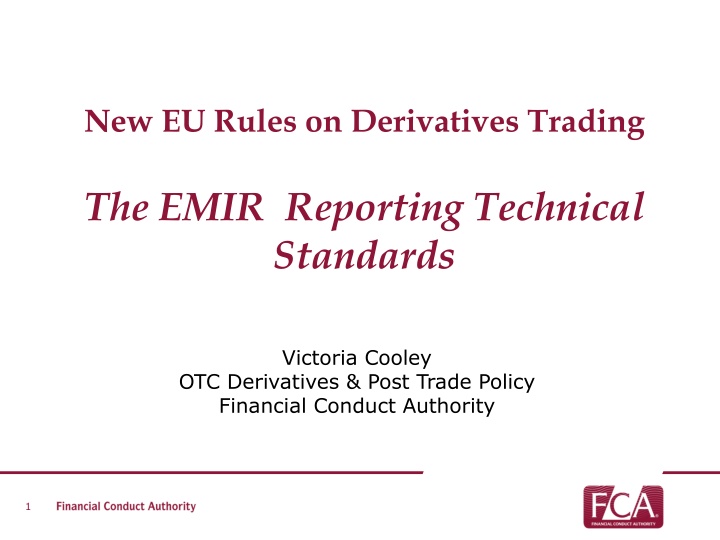

![Guardians of Collection Enhancing Your Trading Card Experience with the Explorer Sleeve Bundle [4-pack]](/thumb/3698/guardians-of-collection-enhancing-your-trading-card-experience-with-the-explorer-sleeve-bundle-4-pack.jpg)


